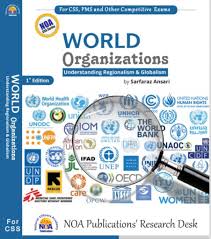World Organizations by Sarfraz Ansari (NOA)
- Understanding Regionalism & Globalism
- SAARC, SCO , ECO , EU , ASEAN , OIC , GCC, ARAB LEAGUE
- UN & All UN bodies
- International Economic Order (WB, IMF, WTO)
- Strategic & Emerging Organization (QUAD,NATO,BRICS,G-20
- MCQ's , Key Terms & Analysis
Best for Competitive Exams (CSS, PMS, PCS & All Descriptive Exams)
PREFACE
Regional and global organizations are part of the CSS/PMS syllabi of both compulsory and optional subjects such as Pakistan Affairs and Current Affairs as well as IR, Political Science, and International Law. Since I have been teaching these organizations for couple of years, the aspirants of CSS/PMS always asked for a single source of reading where they can find all such organizations. Even it was quite challenging for me to find relevant and up-to-date material for preparation of my lectures from a single best source. These limitations gave rise to the idea of writing the book you are holding under the title "World Organizations: Understanding Globalism and Regionalism."
The book contains both historical data and latest information regarding the origin, rise, and functioning of various regional and global organizations in a rapidly changing world affairs both at regional and global levels. The book particularly highlights declining influence, importance, and relevance of certain regional and global organizations such as SAARC, Arab League, and OIC in addressing their old issues and new challenges of the regions these organizations operate in, as well as those world organizations created under the Bretton Woods System of 1945. The controversial role in and control of world affairs by the Western dominant international governmental organizations such as the Security Council, IMF, WTO, and World Bank have been discussed in detail. The book also shed light on the rise of new organizations like SCO, BRICS, and Quad-4 whereby the non-Western nations (typically called the 'Global South in international affairs literature) have started asserting their role and presence demanding their due role and share in managing and controlling world economic, financial, political, and strategic affairs.
I hope the readers will find this book relevant and interesting for expanding their knowledge base and enhancing their understanding of the world and regional affairs in a new way.
SARFRAZ HUSSAIN (PA&AS)
Author
CONTENTS
Section ~ I ~ Regional & Global Organizations
Overview
1. Scope
2. Broader Outline Followed
South Asian Association for Regional Cooperation (SAARC)
1. Historical Background (Why SAARC)
2. SAARC Members
3. SAARC Charter
4. SAARC Objectives
5. Principles (Values) SAARC Promotes
6. SAARC Institutional Framework
7. SAARC: Critical Analysis
8. Importance of SAARC as a Region
9. Issues and Challenges
10. SAARC Success
11. Future of SAARC
12. SAARC: Conclusion
Shanghai cooperation Organization (SCO)
1. Introduction
2. SCO Goals
3. SCO Structure
4. SCO Summit 2022
5. SCO and the Rise of China
6. SCO and Pakistan
7. Conclusion
Economic Cooperation Organization
1. Introduction
2. ECO: Aims and Objectives
3. Membership
4. ECO: Member Countries.
5. Organization Structure
6. ECO and Pakistan
7. ECO Vision 2025
8. Issues and Challenges
9. Future Role in the Region
10. Conclusion
Section-I
Regional and Global Organizations
· Overview
· South Asian Association for Regional Cooperation (SAARC)
· Shanghai Cooperation Organization (SCO)
· Economic Cooperation Organization
· European Union (EU)
· Association of Southeast Asian Nations (ASEAN)
· Organization of Islamic Cooperation (OIC)
· Gulf Cooperation Council (GCC)
· Arab League
OVERVIEW
1. Scope
Since 1900s, the World has evolved into an interdependent system of cooperation and dispute resolution. We, therefore, witness the rise of global and regional organizations as important actors in running and managing world affairs through an intricate system of rules, norms, and values of cooperation, integration, and accommodation. This rule-based system has been serving the purpose of global peace and prosperity since the end of WW-II. We are now living in a global village whereby international travel, trade, and communication have brought global community much closer than that of a century ago. Owing to these development, global and regional cooperation have become a major driving force for greater cooperation in trade, politics, security, and development. Simultaneously, we have been witnessing emergence of events unprecedented in human history. The terrorism, climate crisis, global health concerns, food insecurity, migrations, refugees, and pandemics are, inter alia, such issues which compel the governments, leaders, citizens and originations to behave in a cooperating and peaceful ways so that these existential challenges can be resolved and threats to global peace and prosperity can be overcome. We, nevertheless, see the increasing tendency of both global and regional cooperation. Regarding global cooperation, certain experts, however, opine that the global cooperation is on the decline and globalization is suffering from what they call 'slowbalization', meaning thereby that the Western liberal and capitalistic order has served its purpose and has turned outdated and irrelevant due to the fact that global system has undergone sea change in both political and economic cooperation. Regional cooperation has become more dominant theme than global cooperation due to which the process of globalization has slowed downed i.e. slowbalization of global cooperation and rapid growth of regional organizations such as EU, ASEAN, SCO, BRICS etc have replaced global institutions established in the aftermath of the WW-II.
2. Broader Outline Followed
· Introduction
· Background
· Brief History (Genesis)
· Members (and membership criteria)
· Charter, Objectives, Principles
· Structure
· Functions
· Issues and Challenges
· Geo-Strategic, Geo-Economic, ideological, trade, cultural etc
· Latest/current developments
· Recommendations (if required) & Conclusion
· Future Prospects

